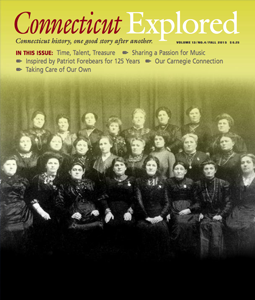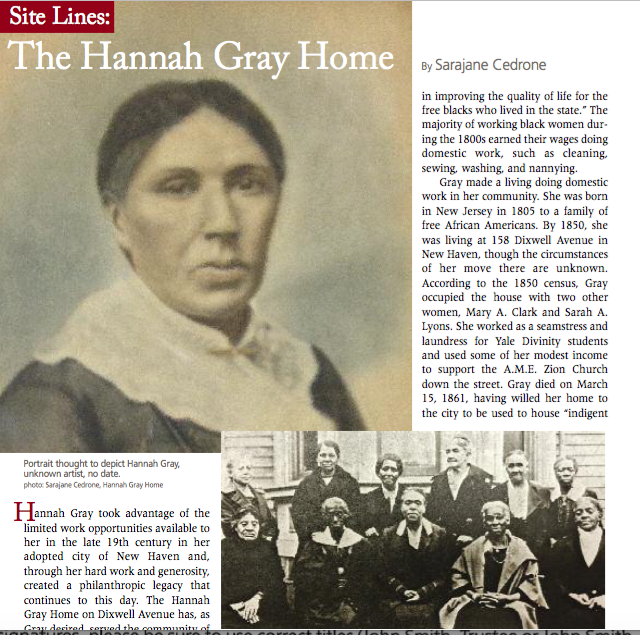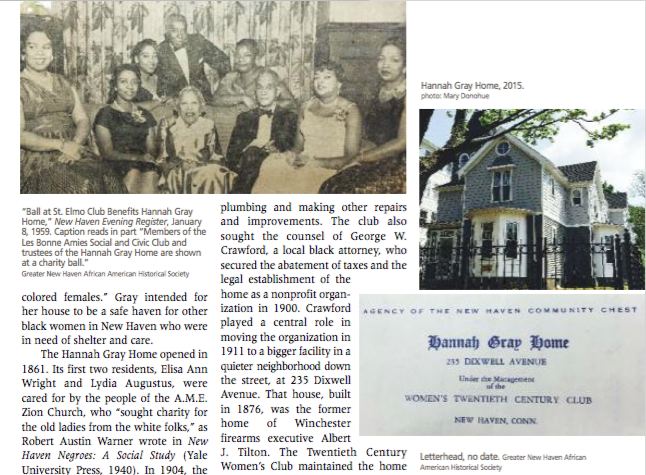By Sarajane Cedrone (c) Connecticut Explored, Fall 2015
Hannah Gray took advantage of the limited work opportunities available to her in the late 19th century in her adopted city of New Haven and, through her hard work and generosity, created a philanthropic legacy that continues to this day. The Hannah Gray Home on Dixwell Avenue has, as Gray desired, served the community of New Haven by housing and caring for the elderly for 150 years.
Despite the fact that New Haven already had a population of more than 900 African Americans by 1850, racial discrimination was still a problem there by the late 1800s. According to An Ethnic History of New Haven (The Ethnic Heritage Center, New Haven, c. 2009), in the mid-19th century “Connecticut whites developed somewhat of a dual attitude toward blacks: sympathy for slaves in the far-away South, but little compassion or interest in improving the quality of life for the free blacks who lived in the state.” The majority of working black women during the 1800s earned their wages doing domestic work, such as cleaning, sewing, washing, and nannying.
Gray made a living doing domestic work in her community. She was born in New Jersey in 1805 to a family of free African Americans. By 1850, she was living at 158 Dixwell Avenue in New Haven, though the circumstances of her move there are unknown. According to the 1850 census, Gray occupied the house with two other women, Mary A. Clark and Sarah A. Lyons. She worked as a seamstress and laundress for Yale Divinity students and used some of her modest income to support the A.M.E. Zion Church down the street. Gray died on March 15, 1861, having willed her home to the city to be used to house “indigent colored females.” Gray intended for her house to be a safe haven for other black women in New Haven who were in need of shelter and care.
The Hannah Gray Home opened in 1861. Its first two residents, Elisa Ann Wright and Lydia Augustus, were cared for by the people of the A.M.E. Zion Church, who “sought charity for the old ladies from the white folks,” as Robert Austin Warner wrote in New Haven Negroes: A Social Study (Yale University Press, 1940). In 1904, the last remaining white trustees to the house, Amos Townsend, and Reverend Edward Strong, died, and the home passed into the hands of Emma Benton and Ernestine Ross, two members of the Twentieth Century Women’s Club, New Haven’s African American women’s club, founded in 1900.
According to Warner, though the Twentieth Century Women’s Club originally formed as a literary circle, its members became interested in the mission of the Hannah Gray Home. The club was deeply involved in the civic development of its community and was known for fighting against saloons and prostitution. The group undertook renovations such as fixing plumbing and making other repairs and improvements. The club also sought the council of George W. Crawford, a local black attorney, who secured the abatement of taxes and the legal establishment of the home as a nonprofit organization in 1900. Crawford played a central role in moving the organization in 1911 to a bigger facility in a quieter neighborhood down the street, at 235 Dixwell Avenue. That house, built in 1876, was the former home of Winchester firearms executive Albert J. Tilton. The Twentieth Century Women’s Club maintained the home and provided for the residents through club dues and donations until 1920, when operation of the home was taken over by New Haven’s Community Chest, and eventually the United Way, until the late 20th century.
 After again falling on hard times, the Hannah Gray Home closed in 1996, but the community rallied to save it. After 10 years of fundraising and renovations to meet the federal standards for historic preservation, it reopened as a 20-bed facility. Though it continues to face challenges, the home still aspires to fulfill Gray’s vision. As Executive Director Robert Page says, “[The] legacy is not one of just race, but of human need.” While Hannah Gray’s home is no longer standing, the current Hannah Gray Home is in the Winchester Repeating Arms Company National Register Historic District and on the Connecticut Freedom Trail. It is not open to the public. For information about the Freedom Trail visit ctfreedomtrail.org.
After again falling on hard times, the Hannah Gray Home closed in 1996, but the community rallied to save it. After 10 years of fundraising and renovations to meet the federal standards for historic preservation, it reopened as a 20-bed facility. Though it continues to face challenges, the home still aspires to fulfill Gray’s vision. As Executive Director Robert Page says, “[The] legacy is not one of just race, but of human need.” While Hannah Gray’s home is no longer standing, the current Hannah Gray Home is in the Winchester Repeating Arms Company National Register Historic District and on the Connecticut Freedom Trail. It is not open to the public. For information about the Freedom Trail visit ctfreedomtrail.org.
Sarajane Cedrone was an intern with Connecticut Explored in Spring 2015. She graduated from the University of Hartford with a double major in English (creative writing) and history.
![]() Connecticut Explored received support for this publication from the State Historic Preservation Office of the Department of Economic and Community Development with funds from the Community Investment Act of the State of Connecticut.
Connecticut Explored received support for this publication from the State Historic Preservation Office of the Department of Economic and Community Development with funds from the Community Investment Act of the State of Connecticut.


